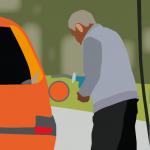Future demand depends on the energy intensity of end use practices and how they change. But which end use practices are changing, at what rate and with what implications for energy demand and CO2-emissions? How do technological innovations, infrastructures and institutions shape innovations in end use practices, and how are they shaped by them? How do interpretations of normality and need evolve? The DEMAND Centre investigates these questions by looking at specific situations, sites and sectors. The common aim is to assess the implications for energy use and for current and new forms of demand management.
- Domestic IT Use
- Home Heating
- Offices and Office Work
- Business Travel
- Online Shopping
- Older People and Mobile Lives
- Local Smart Grids
- Cooking and Cooling in Asia
- Car Dependence
There is no indication that the proliferation of domestic IT/media is slowing. To actively manage demand associated with this new ‘era’ of electrification, we need to know how IT/media has become embedded, and how it has infiltrated, ‘individualised’ and transformed so many areas of practice. While the power draw from individual devices has decreased, the number installed and being powered has risen spectacularly: so much so that people often have several devices running at once.
DEMAND research focuses on three demand-critical aspects: what infrastructures do these devices presume? How do IT devices transform other practices, for example, home shopping, planning trips, watching TV, and with what implications for energy demand? How do IT devices, especially portable ones, influence where end use practices take place, and hence where energy is sourced.
 Hazas, M. and Nathan, L. (eds.) (2017) Digital Technology and Sustainability: Engaging the Paradox This book brings together diverse voices from across the field of sustainable human computer interaction (SHCI) to discuss what it means for digital technology to support sustainability and how humans and technology can work together optimally for a more sustainable future.
Hazas, M. and Nathan, L. (eds.) (2017) Digital Technology and Sustainability: Engaging the Paradox This book brings together diverse voices from across the field of sustainable human computer interaction (SHCI) to discuss what it means for digital technology to support sustainability and how humans and technology can work together optimally for a more sustainable future.
 De Decker, Kris (February 2017) Rebooting Energy Demand: Automatic software updates In this short article, Kris de Decker investigates some of the ways in which energy demand increases behind the scenes. Whether you want them or not, automatic computer, phone and other software updates automatically generate energy demand. This case is indicative of what might be a much wider trend in ‘demand-making’.
De Decker, Kris (February 2017) Rebooting Energy Demand: Automatic software updates In this short article, Kris de Decker investigates some of the ways in which energy demand increases behind the scenes. Whether you want them or not, automatic computer, phone and other software updates automatically generate energy demand. This case is indicative of what might be a much wider trend in ‘demand-making’.
Lane, R (2017) Communications technology, life course transitions, and energy demand [.pdf] A report written by Ruth Lane relating to the work she undertook during her DEMAND Centre fellowship in the summer of 2017. The report considers the challenge to the idea of sustainable consumption brought about by the rapid uptake and turnover of communications technology (IT) in affluent countries, focusing on households in Australia.
 Morley, J. and Lord, C. (2016) Changing connections: Wifi, tablets and evolving systems of connectivity [.pdf], Paper prepared for DEMAND Centre Conference, Lancaster, 13-15 April 2016. This paper represents a combined effort to connect our research into two aspects of the Internet’s expanding ‘system of connectivity’: the emergence of Wi-Fi and of tablet computers. In their own right both are fascinating cases for exploring change associated with emerging technologies. Yet Wi-Fi and tablet computers are inherently interconnected to one another. By combining these cases, this paper highlights aspects of the evolution of this system of connectivity over time in a way that would not be possible by focusing on one device or the other.
Morley, J. and Lord, C. (2016) Changing connections: Wifi, tablets and evolving systems of connectivity [.pdf], Paper prepared for DEMAND Centre Conference, Lancaster, 13-15 April 2016. This paper represents a combined effort to connect our research into two aspects of the Internet’s expanding ‘system of connectivity’: the emergence of Wi-Fi and of tablet computers. In their own right both are fascinating cases for exploring change associated with emerging technologies. Yet Wi-Fi and tablet computers are inherently interconnected to one another. By combining these cases, this paper highlights aspects of the evolution of this system of connectivity over time in a way that would not be possible by focusing on one device or the other.
 Hazas, M., Morley, J., Bates, O. and Friday, A. (2016) Are there limits to growth in data traffic?: on time use, data generation and speed , In this paper, the authors selectively explore aspects of data growth that are linked to everyday practices, exploring the way that they draw upon and generate Internet data.
Hazas, M., Morley, J., Bates, O. and Friday, A. (2016) Are there limits to growth in data traffic?: on time use, data generation and speed , In this paper, the authors selectively explore aspects of data growth that are linked to everyday practices, exploring the way that they draw upon and generate Internet data.
 Strengers, Y., Morley, J., Nicholls, L. and Hazas, M. (2015) The hidden energy cost of smart homes, The Conversation, June 12th, 2016. This article discusses the paradox of energy-saving smart homes by identifying three “hidden” energy impacts rarely considered in IOT research, or energy-saving predictions.
Strengers, Y., Morley, J., Nicholls, L. and Hazas, M. (2015) The hidden energy cost of smart homes, The Conversation, June 12th, 2016. This article discusses the paradox of energy-saving smart homes by identifying three “hidden” energy impacts rarely considered in IOT research, or energy-saving predictions.
 Hazas, M. (2015) Society pushes to go faster, but data binges carry environmental costs, The Conversation, January 27, 2015. Given the resources marshalled to support continued rises in data volume and ever-faster speeds, we should also be debating what kinds of digital services have real social importance. It’s great that it’s so easy to keep in contact with close friends and family, almost anywhere in the world. Yet at a time when we are battling to keep carbon emissions under control, can we really justify the energy consumption involved in streaming cat videos in ever-higher definition?
Hazas, M. (2015) Society pushes to go faster, but data binges carry environmental costs, The Conversation, January 27, 2015. Given the resources marshalled to support continued rises in data volume and ever-faster speeds, we should also be debating what kinds of digital services have real social importance. It’s great that it’s so easy to keep in contact with close friends and family, almost anywhere in the world. Yet at a time when we are battling to keep carbon emissions under control, can we really justify the energy consumption involved in streaming cat videos in ever-higher definition?
 Bates, O., M. Hazas, A. Friday, J. Morley, A. Clear (2014) Towards an holistic view of the energy and environmental impacts of domestic media and IT, Proceedings of the SIGCHI Conference on Human Factors in Computing Systems (CHI ’14). ACM Press: New York, 1173-1182. DOI: 10.1145/2556288.2556968. To date, research in sustainable HCI has dealt with ecofeedback, usage and recycling of appliances within the home, and longevity of portable electronics such as mobile phones. However, there seems to be less awareness of the energy and greenhouse emissions impacts of domestic consumer electronics and information technology. This research paper discusses more fruitful directions that sustainable HCI research might take.
Bates, O., M. Hazas, A. Friday, J. Morley, A. Clear (2014) Towards an holistic view of the energy and environmental impacts of domestic media and IT, Proceedings of the SIGCHI Conference on Human Factors in Computing Systems (CHI ’14). ACM Press: New York, 1173-1182. DOI: 10.1145/2556288.2556968. To date, research in sustainable HCI has dealt with ecofeedback, usage and recycling of appliances within the home, and longevity of portable electronics such as mobile phones. However, there seems to be less awareness of the energy and greenhouse emissions impacts of domestic consumer electronics and information technology. This research paper discusses more fruitful directions that sustainable HCI research might take.
 Hazas, M. and Morley, J. (2016) The next frontier in our digital revolution. Submission to UK Digital Strategy. The DEMAND Centre responded to UK Digital Strategy’s call for evidence on ‘The next frontier in our digital revolution’ and focus on how resilience and energy demand must be considered alongside economic growth.
Hazas, M. and Morley, J. (2016) The next frontier in our digital revolution. Submission to UK Digital Strategy. The DEMAND Centre responded to UK Digital Strategy’s call for evidence on ‘The next frontier in our digital revolution’ and focus on how resilience and energy demand must be considered alongside economic growth.
 Lord, C., Hazas, M., Clear, A. K., Bates, O., Whittam, R., Morley, J. and Friday, A. (2015) Demand in My Pocket: Mobile Devices and the Data Connectivity Marshalled in Support of Everyday Practice [PDF]. In: Begole, B., Kim, J., Inkpen, K. and Woo, W., eds. Proceedings of CHI Conference: One of a CHInd, Toronto, Canada. ACM, 2729-2738. DOI: 10.1145/2702162. This paper empirically explores the role that mobile devices have come to play in everyday practice, and how this links to demand for network connectivity and online services. After a preliminary device-logging period, thirteen participants were interviewed about how they use their iPhones or iPads. Our findings build a picture of how, through use of such devices, a variety of daily practices have come to depend upon a working data connection, which sometimes surges, but is at least always a trickle.
Lord, C., Hazas, M., Clear, A. K., Bates, O., Whittam, R., Morley, J. and Friday, A. (2015) Demand in My Pocket: Mobile Devices and the Data Connectivity Marshalled in Support of Everyday Practice [PDF]. In: Begole, B., Kim, J., Inkpen, K. and Woo, W., eds. Proceedings of CHI Conference: One of a CHInd, Toronto, Canada. ACM, 2729-2738. DOI: 10.1145/2702162. This paper empirically explores the role that mobile devices have come to play in everyday practice, and how this links to demand for network connectivity and online services. After a preliminary device-logging period, thirteen participants were interviewed about how they use their iPhones or iPads. Our findings build a picture of how, through use of such devices, a variety of daily practices have come to depend upon a working data connection, which sometimes surges, but is at least always a trickle.
 Wiig, A. (2016) Demanding connectivity: the co-production of mobile communication through electrical and digital infrastructures (PDF), Paper prepared for DEMAND Centre Conference, Lancaster, 13-15 April 2016. Supporting ubiquitous digital communication is both the infrastructure of wireless connectivity but also the wired, global telecommunications systems of the internet itself. These systems require not-insignificant amounts of electricity. Conceptualizing the energy demand of mobile communication begins by considering the interweaving of infrastructures with expectations of constant service pulsing through social practices of connectivity and charging.
Wiig, A. (2016) Demanding connectivity: the co-production of mobile communication through electrical and digital infrastructures (PDF), Paper prepared for DEMAND Centre Conference, Lancaster, 13-15 April 2016. Supporting ubiquitous digital communication is both the infrastructure of wireless connectivity but also the wired, global telecommunications systems of the internet itself. These systems require not-insignificant amounts of electricity. Conceptualizing the energy demand of mobile communication begins by considering the interweaving of infrastructures with expectations of constant service pulsing through social practices of connectivity and charging.
Conventions of comfort have changed significantly over the last few decades. Our research on the design of council houses and home heating systems in Stocksbridge (near Sheffield) and Stevenage, combined with detailed oral histories from people who have lived in these houses at different points in the past provides new insights into the relationship between infrastructures, daily rhythms and the uses of space in the home.
 Shove, E. (2018) The Cloak of DEMAND In recognising that heating a person, and keeping the heat from a person, is more effective than space heating, The Cloak of DEMAND provides a more practical suggestion to reduce the energy required for home heating.
Shove, E. (2018) The Cloak of DEMAND In recognising that heating a person, and keeping the heat from a person, is more effective than space heating, The Cloak of DEMAND provides a more practical suggestion to reduce the energy required for home heating.
 Kuijer, L, Watson, M. (2017) That’s when we started using the living room’: Lessons from a local history of domestic heating in the United Kingdom Energy Research and Social Science, 28, 77-85. DOI: 10.1016/j.erss.2017.04.010 This paper provides a detailed analysis of historical change across infrastructures and practices reveals processes underpinning increasing demand for heat. By focusing on patterns of practice we reveal new insights for contemporary energy policy addressing domestic heat consumption.
Kuijer, L, Watson, M. (2017) That’s when we started using the living room’: Lessons from a local history of domestic heating in the United Kingdom Energy Research and Social Science, 28, 77-85. DOI: 10.1016/j.erss.2017.04.010 This paper provides a detailed analysis of historical change across infrastructures and practices reveals processes underpinning increasing demand for heat. By focusing on patterns of practice we reveal new insights for contemporary energy policy addressing domestic heat consumption.
 Carlsson-Hyslop, A. (2016). Past Management of Energy Demand: Promotion and Adoption of Electric Heating in Britain 1945-1964. Environment and History, 22, 75-102. DOI: 10.3197/096734016X14497391602242. This paper discusses electric heating in early post-war Britain, which was seen as a particularly problematic energy use, as electric fires were used at peak times. The Electricity Development Association (EDA) tried simultaneously to reduce undesirable peak demand while encouraging increased demand more generally. The paper concludes that, while demand management has been attempted by the electricity industry since well before the 1970s, these attempts only had a limited effect on the overall trend towards increasing demand, in part to do with how these promotions were adopted.
Carlsson-Hyslop, A. (2016). Past Management of Energy Demand: Promotion and Adoption of Electric Heating in Britain 1945-1964. Environment and History, 22, 75-102. DOI: 10.3197/096734016X14497391602242. This paper discusses electric heating in early post-war Britain, which was seen as a particularly problematic energy use, as electric fires were used at peak times. The Electricity Development Association (EDA) tried simultaneously to reduce undesirable peak demand while encouraging increased demand more generally. The paper concludes that, while demand management has been attempted by the electricity industry since well before the 1970s, these attempts only had a limited effect on the overall trend towards increasing demand, in part to do with how these promotions were adopted.
 Spurling, N. and Shove, E. (2015) If the walls could talk: histories of homes and domestic energy use in Stevenage. A talk and two picture books. Daily rhythms and energy use in Stevenage[.pdf] and Central heating comes to Stevenage[.pdf]: These short picture books were produced for an event at the Stevenage Museum, looking at how energy use in everyday life has changed between 1950 and the present. The picture books describe the different kinds of home heating that Stevenage residents had lived with, and how that impacted daily life. These stories tell a larger tale about how infrastructures and practices evolve together.
Spurling, N. and Shove, E. (2015) If the walls could talk: histories of homes and domestic energy use in Stevenage. A talk and two picture books. Daily rhythms and energy use in Stevenage[.pdf] and Central heating comes to Stevenage[.pdf]: These short picture books were produced for an event at the Stevenage Museum, looking at how energy use in everyday life has changed between 1950 and the present. The picture books describe the different kinds of home heating that Stevenage residents had lived with, and how that impacted daily life. These stories tell a larger tale about how infrastructures and practices evolve together.
 Rinkinen, J., Jalas, M. and Shove, E. (2015). Object Relations in Accounts of Everyday Life [PDF], Sociology 49(5), 870-885. DOI: 10.1177/0038038515577910. By drawing on an archive of diary material, this article illustrates multi-faceted object relations with reference to the example of keeping warm. It uses experience of keeping warm to characterise tactics, judgements and engagements with objects that extend beyond the ‘mere’ enactment of social practice. In analysing these encounters we explore ways of conceptualising the object-world that are especially relevant for studies of everyday life
Rinkinen, J., Jalas, M. and Shove, E. (2015). Object Relations in Accounts of Everyday Life [PDF], Sociology 49(5), 870-885. DOI: 10.1177/0038038515577910. By drawing on an archive of diary material, this article illustrates multi-faceted object relations with reference to the example of keeping warm. It uses experience of keeping warm to characterise tactics, judgements and engagements with objects that extend beyond the ‘mere’ enactment of social practice. In analysing these encounters we explore ways of conceptualising the object-world that are especially relevant for studies of everyday life
 Shove, E. and Royston, S. (2014) Smart meters don’t make us any smarter about energy use. The Conversation. Energy bills are higher on the political agenda than ever before and we are constantly being told that devices such as smart meters will help us make better decisions and take control of the energy we use. But evidence shows that these new technologies are not making us more savvy.
Shove, E. and Royston, S. (2014) Smart meters don’t make us any smarter about energy use. The Conversation. Energy bills are higher on the political agenda than ever before and we are constantly being told that devices such as smart meters will help us make better decisions and take control of the energy we use. But evidence shows that these new technologies are not making us more savvy.

 Transitions in heat – the arrival and disappearance of gas central heating, Research Insight 7, DEMAND Centre. Gas central heating accounts for a significant proportion of the residential sector’s UK greenhouse gas emissions but its introduction was not a matter of one technology replacing another. With current proposals to reduce these emissions to ‘almost zero’ by 2050, examining the introduction of gas central heating and its related practices has implications for future changes to how we heat our homes.
Transitions in heat – the arrival and disappearance of gas central heating, Research Insight 7, DEMAND Centre. Gas central heating accounts for a significant proportion of the residential sector’s UK greenhouse gas emissions but its introduction was not a matter of one technology replacing another. With current proposals to reduce these emissions to ‘almost zero’ by 2050, examining the introduction of gas central heating and its related practices has implications for future changes to how we heat our homes.
Commercial, industrial and public sector buildings account for around 20% of UK CO2 emissions. Our work on offices shows how understandings of ‘normal’ standards are made, how competing interpretations of acceptable, marketable and desirable office environments are resolved and where opportunities lie for managing energy demand by negotiating user needs at different points in the building lifecycle.
A study of the design and specification processes associated with building and refurbishing ten commercial office buildings in London has provided insights into how escalating expectations and standards of assumed user needs are designed into the fabric and services of buildings, creating rising ‘designed in’ energy demand, in particular because of choices about cooling systems and ‘power loads’.
 Cass, N. Faulconbridge, J. and Connaughton, J. (2016) Negotiating needs and expectations in commercial buildings – summary of key findings and conclusions (PDF), This research explored the energy implications of the design and specification of ten new and refurbished office development projects in London. The summary report explains how escalating expectations of assumed user needs, and their associated standards are designed into the fabric and services of buildings, affecting energy demand, e.g. through choices about cooling systems and levels of ‘small power’. The report was sent to participants of a roundtable event about energy and office standards organised by DEMAND researchers.
Cass, N. Faulconbridge, J. and Connaughton, J. (2016) Negotiating needs and expectations in commercial buildings – summary of key findings and conclusions (PDF), This research explored the energy implications of the design and specification of ten new and refurbished office development projects in London. The summary report explains how escalating expectations of assumed user needs, and their associated standards are designed into the fabric and services of buildings, affecting energy demand, e.g. through choices about cooling systems and levels of ‘small power’. The report was sent to participants of a roundtable event about energy and office standards organised by DEMAND researchers.
 Cass, N (2016) Report on the ISF/Demand Workshop on Office (Work) Futures. A workshop funded by the Institute for Social Futures was held on June 22nd on ‘Office (Work) Future(s)’, where a group of academics and practitioners discussed how changes in office buildings and increasingly flexible and mobile work practices might develop in the future. The attendees included academics from Lancaster, Leeds, Leicester, Cambridge and Sheffield, Cathy Garner from the Work Foundation and Lancaster University’s Energy Manager Jan Bastiaans. The basis of discussions were presentations made by attendees in response to a background document [.pdf] prepared before the event
Cass, N (2016) Report on the ISF/Demand Workshop on Office (Work) Futures. A workshop funded by the Institute for Social Futures was held on June 22nd on ‘Office (Work) Future(s)’, where a group of academics and practitioners discussed how changes in office buildings and increasingly flexible and mobile work practices might develop in the future. The attendees included academics from Lancaster, Leeds, Leicester, Cambridge and Sheffield, Cathy Garner from the Work Foundation and Lancaster University’s Energy Manager Jan Bastiaans. The basis of discussions were presentations made by attendees in response to a background document [.pdf] prepared before the event
 De Decker, K (November 2016). The Curse of the Modern Office The information society promises to dematerialise society and make it more sustainable, but modern office and knowledge work has itself become a large and rapidly growing consumer of energy and other resources.
De Decker, K (November 2016). The Curse of the Modern Office The information society promises to dematerialise society and make it more sustainable, but modern office and knowledge work has itself become a large and rapidly growing consumer of energy and other resources.
 Faulconbridge, J., Cass, N. and Connaughton, J. (2017) How market standards affect building design: the case of low energy design in commercial offices [.pdf] Environment and Planning A. In this paper, the concept of ‘market standards’ is developed to explain how norms and cultural expectations operate in the field of commercial office design to format property markets, diminish knowledge of occupiers’ practices, and to legitimise and value more energy-demanding designs over less demanding possibilities
Faulconbridge, J., Cass, N. and Connaughton, J. (2017) How market standards affect building design: the case of low energy design in commercial offices [.pdf] Environment and Planning A. In this paper, the concept of ‘market standards’ is developed to explain how norms and cultural expectations operate in the field of commercial office design to format property markets, diminish knowledge of occupiers’ practices, and to legitimise and value more energy-demanding designs over less demanding possibilities
 Faulconbridge, J., Cass, N. and Connaughton, J. (2016) Standards, design and energy demand: the case of commercial offices (PDF), Paper prepared for DEMAND Centre Conference, Lancaster, 13-15 April 2016. This paper examines the influence of ‘market standards’ on the design and energy demand of speculative office buildings. The paper argues that standards designed to reduce escalating energy consumption can have the opposite effect.
Faulconbridge, J., Cass, N. and Connaughton, J. (2016) Standards, design and energy demand: the case of commercial offices (PDF), Paper prepared for DEMAND Centre Conference, Lancaster, 13-15 April 2016. This paper examines the influence of ‘market standards’ on the design and energy demand of speculative office buildings. The paper argues that standards designed to reduce escalating energy consumption can have the opposite effect.
![]() Understanding buildings and their uses, sound bite by John Connaughton, who talks about the importance of examining the social practices that are carried out in buildings in order to understand energy demand.
Understanding buildings and their uses, sound bite by John Connaughton, who talks about the importance of examining the social practices that are carried out in buildings in order to understand energy demand.
 Cass, N., Faulconbridge, J., Connaughton, J. and Shove, E. (2015) Design Commission Enquiry: design and behaviour in the built environment. Evidence given to a Design Commission enquiry on design and behaviour in the built environment. She was invited in response to an official submission to the enquiry.
Cass, N., Faulconbridge, J., Connaughton, J. and Shove, E. (2015) Design Commission Enquiry: design and behaviour in the built environment. Evidence given to a Design Commission enquiry on design and behaviour in the built environment. She was invited in response to an official submission to the enquiry.

 Demanding offices – How market standards drive up energy demand, Research Insight 6, DEMAND Centre. Research into how those procuring and letting office buildings increase energy demand by following ‘market standards’. Office design is heavily influenced by these standards to create offices that are flexible and high-specification but alternative designs can reduce demand while being desirable.
Demanding offices – How market standards drive up energy demand, Research Insight 6, DEMAND Centre. Research into how those procuring and letting office buildings increase energy demand by following ‘market standards’. Office design is heavily influenced by these standards to create offices that are flexible and high-specification but alternative designs can reduce demand while being desirable.
Business travel accounts for 20% of journeys over 50 km, and for 25% of domestic and international flights, but what are these trips for? How do needs for co-presence relate to trends in organisational and economic practice such as outsourcing, knowledge production, conferences and training, recruiting, demonstrating and selling? Which occupations are the most travel-intensive and why? While much research has been done, there is still more to learn about the evolving demand for business travel.
 Burkinshaw, J. (2017) ‘The tenuous and complex relationship between flexible working practices and travel demand reduction’, In Demanding Energy: Space, Time and Change (eds Hui, A., Day, R. and Walker, G.). Cham: Palgrave. Drawing from 29 qualitative interviews, this chapter challenges existing policy approaches as they relate to the car, suggesting that the flexibility of work does not necessarily equate to flexibility in commuting.
Burkinshaw, J. (2017) ‘The tenuous and complex relationship between flexible working practices and travel demand reduction’, In Demanding Energy: Space, Time and Change (eds Hui, A., Day, R. and Walker, G.). Cham: Palgrave. Drawing from 29 qualitative interviews, this chapter challenges existing policy approaches as they relate to the car, suggesting that the flexibility of work does not necessarily equate to flexibility in commuting.
 Jones, I., Faulconbridge, J., Marsden, G. and Anable, J. (2017) ‘Demanding Business Travel: The Evolution of the Timespaces of Business Practice’, In Demanding Energy: Space, Time and Change (eds Hui, A., Day, R. and Walker, G.). Cham: Palgrave. In building on the idea that virtual ways of working have yet to substantially reduce demand for business travel, this chapter draws upon Schatzki’s conception of timespace to capture changes in how two UK-based global construction and engineering consulting firms organise work and the implications in terms of demand for business travel.
Jones, I., Faulconbridge, J., Marsden, G. and Anable, J. (2017) ‘Demanding Business Travel: The Evolution of the Timespaces of Business Practice’, In Demanding Energy: Space, Time and Change (eds Hui, A., Day, R. and Walker, G.). Cham: Palgrave. In building on the idea that virtual ways of working have yet to substantially reduce demand for business travel, this chapter draws upon Schatzki’s conception of timespace to capture changes in how two UK-based global construction and engineering consulting firms organise work and the implications in terms of demand for business travel.
 De Decker, K (April 2017) Why do (Business) People Travel? In this piece, Kris de Decker looks at how investments in telecommunications aimed at reducing business travel actually serves to compliment or encourage it by spatially extending business networks.
De Decker, K (April 2017) Why do (Business) People Travel? In this piece, Kris de Decker looks at how investments in telecommunications aimed at reducing business travel actually serves to compliment or encourage it by spatially extending business networks.
 Annable, J. Faulconbridge, J., Jones, I. and Marsden, G. (2016) Business travel: exploring how changes in the arrangement and negotiation of professional work generate demand for travel, paper prepared for DEMAND Centre Conference, Lancaster, 13-15 April 2016. Understanding growth in business travel requires a critical exploration of how the demand arises from the arrangement and negotiation of work. This paper applies a system of practice perspective to help reveal the multidimensional factors that contribute to business travel.
Annable, J. Faulconbridge, J., Jones, I. and Marsden, G. (2016) Business travel: exploring how changes in the arrangement and negotiation of professional work generate demand for travel, paper prepared for DEMAND Centre Conference, Lancaster, 13-15 April 2016. Understanding growth in business travel requires a critical exploration of how the demand arises from the arrangement and negotiation of work. This paper applies a system of practice perspective to help reveal the multidimensional factors that contribute to business travel.
![]() The evolving demand for business travel, sound bite in which James Faulconbridge talks about the changes in demand for business travel across time and sectors, the evolution of business travel and the implications for future demand.
The evolving demand for business travel, sound bite in which James Faulconbridge talks about the changes in demand for business travel across time and sectors, the evolution of business travel and the implications for future demand.
 Strengers, Y. (2014) Fly or die: air travel and the internationalisation of academic careers, Demand blog, June 4, 2014. Business air travel is on the rise globally, especially in knowledge organisations such as universities. Academics who study energy consumption, climate change and sustainability find themselves in an especially awkward position. Their job is to develop ideas about how to reduce and address a growing list of environmental and energy problems, but to take these ideas to audiences around the world they ‘need’ to travel.
Strengers, Y. (2014) Fly or die: air travel and the internationalisation of academic careers, Demand blog, June 4, 2014. Business air travel is on the rise globally, especially in knowledge organisations such as universities. Academics who study energy consumption, climate change and sustainability find themselves in an especially awkward position. Their job is to develop ideas about how to reduce and address a growing list of environmental and energy problems, but to take these ideas to audiences around the world they ‘need’ to travel.
 Strengers, Y. and Bille, M. (2016) The temporal dynamics of being an international visiting scholar, Demand blog, May 16, 2016. Academia is increasingly concerned with international connections and collaboration. While the benefits of such endeavours are increasingly discussed, we rarely acknowledge their effects. In this short piece of writing we are interested in the ways in which one globalising move — the appointment of the ‘visiting academic’ — disrupts and rearranges the temporal routines of academics’ everyday lives.
Strengers, Y. and Bille, M. (2016) The temporal dynamics of being an international visiting scholar, Demand blog, May 16, 2016. Academia is increasingly concerned with international connections and collaboration. While the benefits of such endeavours are increasingly discussed, we rarely acknowledge their effects. In this short piece of writing we are interested in the ways in which one globalising move — the appointment of the ‘visiting academic’ — disrupts and rearranges the temporal routines of academics’ everyday lives.
 Jones, I., Anable, J., Falconbridge, J. and Marsden, G. (2016) Understanding how enacting business practices maintains and generates demand for business travel. Paper presented at the World Conference on Transport Research, Shanghai, July 2016.
Jones, I., Anable, J., Falconbridge, J. and Marsden, G. (2016) Understanding how enacting business practices maintains and generates demand for business travel. Paper presented at the World Conference on Transport Research, Shanghai, July 2016.
We are looking at how demand for internet shopping is creating a demand for delivery. Light van traffic has grown by 30% since 2001 and in 2010 accounted for 41 billion miles travelled whilst car traffic levels have grown by only 1% over the same period. This trend, which represents a major challenge for reducing energy use in the transport sector, is in part related to the extensive growth of home delivery linked to teleshopping and online purchasing. One of the key questions is how methods and systems of shopping and delivering might be steered with consideration of the implications for CO2-emissions.

Research Insight. The last mile and the next day [.pdf] Different modes of shopping (corner shop, supermarket, online) affect the movements of goods and people and the energy demands that follow, and involve consumers, retailers, and distributors alike. These patterns of energy and travel demand vary depending on how these modes are organised in time and space. This research insight considers the relation between physical and online shopping and the implications of both for travel and energy demand.
Different modes of shopping (corner shop, supermarket, online) affect the movements of goods and people and the energy demands that follow, and involve consumers, retailers, and distributors alike. These patterns of energy and travel demand vary depending on how these modes are organised in time and space. This research insight considers the relation between physical and online shopping and the implications of both for travel and energy demand.
Mobility amongst older people constitutes a significant and growing area of demand. The population is ageing and on average health and life expectancy on retirement has increased. Older people are making more long distance trips than ever before and there is evidence that travel is a major aspiration for those who retire. Mobility is often encouraged as a means of ensuring wellbeing and combating social isolation.

 Research Insight. A later-life travel boom? Understanding change in leisure mobility.[.pdf]
Research Insight. A later-life travel boom? Understanding change in leisure mobility.[.pdf]
 Day, R., Hitchings, R., Fox, E., Venn, S. and Hibbert, J. (2017) ‘Leisure travel and the time of later life’, In Demanding Energy: Space, Time and Change (eds Hui, A., Day, R. and Walker, G.). Cham: Palgrave. In undertaking serial interviews with a cohort approaching retirement, another who were recently retired, and a third cohort who had been retired for longer, this chapter explores the evolving demand for energy-intensive long distance leisure travel in retirement; a phenomenon which is widely predicted to be on the increase due to demographic change, rising retirement incomes and the retirement of the baby boomer generation, who are often labelled as the first consumer generations.
Day, R., Hitchings, R., Fox, E., Venn, S. and Hibbert, J. (2017) ‘Leisure travel and the time of later life’, In Demanding Energy: Space, Time and Change (eds Hui, A., Day, R. and Walker, G.). Cham: Palgrave. In undertaking serial interviews with a cohort approaching retirement, another who were recently retired, and a third cohort who had been retired for longer, this chapter explores the evolving demand for energy-intensive long distance leisure travel in retirement; a phenomenon which is widely predicted to be on the increase due to demographic change, rising retirement incomes and the retirement of the baby boomer generation, who are often labelled as the first consumer generations.
 Hitchings, R., Day, R., Venn, S., and Fox, E. (2016) Our time now? Entitlement and post retirement leisure travel, Paper prepared for DEMAND Centre Conference, Lancaster, 13-15 April 2016. Retirement increases leisure time and with the greater availability of time often comes for many people the possibility of travel of all kinds whether it is for its own sake, as in tourism, or in order to engage in other leisure activities or to spend time with friends. In-depth interviews with older people in the UK show that the notion of retirement as a time of personal fulfilment and reward is certainly present, but to what extent and with what implications for travel and resultant energy demand?
Hitchings, R., Day, R., Venn, S., and Fox, E. (2016) Our time now? Entitlement and post retirement leisure travel, Paper prepared for DEMAND Centre Conference, Lancaster, 13-15 April 2016. Retirement increases leisure time and with the greater availability of time often comes for many people the possibility of travel of all kinds whether it is for its own sake, as in tourism, or in order to engage in other leisure activities or to spend time with friends. In-depth interviews with older people in the UK show that the notion of retirement as a time of personal fulfilment and reward is certainly present, but to what extent and with what implications for travel and resultant energy demand?
 Hitchings, R., Venn, S. and Day, R. (2016) Assumptions about later life travel and their implications: pushing people around? Ageing and Society DOI: 10.1017/S0144686X16000738. This review article takes four assumptions in turn and considers some of the lenses through which researchers might look at later life leisure travel and the implications of adopting each of them.
Hitchings, R., Venn, S. and Day, R. (2016) Assumptions about later life travel and their implications: pushing people around? Ageing and Society DOI: 10.1017/S0144686X16000738. This review article takes four assumptions in turn and considers some of the lenses through which researchers might look at later life leisure travel and the implications of adopting each of them.
![]() Examining how demand for travel among older people is changing, sound bite in which Rosie Day explains some of the possible changes in demand for travel among older people.
Examining how demand for travel among older people is changing, sound bite in which Rosie Day explains some of the possible changes in demand for travel among older people.
![]() Changing understandings of older people’s travel, sound bite in which Russell Hitchings talks about how different groups of older people respond to ideas about travel demand and how these ideas circulate.
Changing understandings of older people’s travel, sound bite in which Russell Hitchings talks about how different groups of older people respond to ideas about travel demand and how these ideas circulate.
The role of the electricity meter has been re-invigorated by the wider digitalisation of data systems and infrastructures, for example, some meters will now transmit data every half-hour or on a second-by-second basis and can be flexibly positioned to record energy flow following various logics, not just for billing customers. In the domestic space, the “new” meter has become known as a ‘smart’ meter, while in the non-domestic world of businesses and public sector organisations, the ‘advanced meters’ have been ‘smart’ for some time. These types of electricity meters are now becoming increasingly significant and integral to visions of low carbon energy futures. Yet, in what ways do these meter data infrastructures and practices generate possibilities for the governance of energy demand? In this research, we are particularly interested in the work of sub-metering within large businesses and organisations as well as with metering associated with demand-response contracts. We are interested in how metering and data infrastructures are integral to new expectations about how demand will be governed and made flexible, and how electricity flows are being re-monetised through their mobilisation as data
 Kragh-Furbo, M and Walker, G (2016) Metering Work, Meaning, Value, Governance (PDF), paper presented at the 3rd Energy & Society Conference, Leipzig, Germany, 11-14 September 2016
Kragh-Furbo, M and Walker, G (2016) Metering Work, Meaning, Value, Governance (PDF), paper presented at the 3rd Energy & Society Conference, Leipzig, Germany, 11-14 September 2016
We know that energy-demanding technologies like fridge-freezers are spreading around the world. How do these and other standardised appliances become part of established and previously very variable routines and habits of cooking and cooling? To understand how practices converge and diverge globally, the DEMAND centre conducted empirical fieldwork in Bangkok and Hanoi, both locations which allowed us to examine , recent and projected rapid changes in systems of provision, patterns of domestic practice and related technological devices.
 Rinkinen, J, Shove, E, and Smits, M (2017) Cold chains in Hanoi and Bangkok: Changing systems of provision and practice DOI: 10.1177/1469540517717783. In analysing the uses of fridge freezers in Hanoi and Bangkok as expressions, in microcosm, of complex and evolving processes of urbanisation and food provisioning, this article provides new insight into how specific configurations, dependencies and patterns of consumption take hold and how they vary and change.
Rinkinen, J, Shove, E, and Smits, M (2017) Cold chains in Hanoi and Bangkok: Changing systems of provision and practice DOI: 10.1177/1469540517717783. In analysing the uses of fridge freezers in Hanoi and Bangkok as expressions, in microcosm, of complex and evolving processes of urbanisation and food provisioning, this article provides new insight into how specific configurations, dependencies and patterns of consumption take hold and how they vary and change.
 Research Insight: What’s in the Fridge? Urbanisation, consumption and demand in Bangkok and Hanoi [.pdf]
Research Insight: What’s in the Fridge? Urbanisation, consumption and demand in Bangkok and Hanoi [.pdf]
 Rinkinen, J. and Smits, M. (2016) Conceptualising conjunctions: understanding change in energy related practices in urban southeast Asia, Paper prepared for DEMAND Centre Conference, Lancaster, 13-15 April 2016. This paper, which is based on empirical fieldwork conducted in Bangkok, Thailand and Hanoi, Vietnam in February and March 2016, focuses on energy demanding practices which seem to converge and travel between societies. It highlights the importance of ‘conjunctions’ of practice, alongside instances and examples of product diffusion.
Rinkinen, J. and Smits, M. (2016) Conceptualising conjunctions: understanding change in energy related practices in urban southeast Asia, Paper prepared for DEMAND Centre Conference, Lancaster, 13-15 April 2016. This paper, which is based on empirical fieldwork conducted in Bangkok, Thailand and Hanoi, Vietnam in February and March 2016, focuses on energy demanding practices which seem to converge and travel between societies. It highlights the importance of ‘conjunctions’ of practice, alongside instances and examples of product diffusion.
 Smits, M. (2016) Unpacking convergence/divergence: comparing elements, practices and conjunctions of middle-class households in Bangkok and Hanoi (PDF), Paper prepared for DEMAND Centre Conference, Lancaster, 13-15 April 2016. Energy demand is growing in many parts of the world, in particular in non-OECD countries. While there are still big gaps between levels of energy consumption in different countries some of these are closing rapidly. This convergence in levels of consumption and demand has been widely discussed in social science literature. However, lots of questions remain. What is it exactly that is converging or diverging? Is it energy systems, culture, objects, ideas or practices? Within these, what is different and what remains similar?
Smits, M. (2016) Unpacking convergence/divergence: comparing elements, practices and conjunctions of middle-class households in Bangkok and Hanoi (PDF), Paper prepared for DEMAND Centre Conference, Lancaster, 13-15 April 2016. Energy demand is growing in many parts of the world, in particular in non-OECD countries. While there are still big gaps between levels of energy consumption in different countries some of these are closing rapidly. This convergence in levels of consumption and demand has been widely discussed in social science literature. However, lots of questions remain. What is it exactly that is converging or diverging? Is it energy systems, culture, objects, ideas or practices? Within these, what is different and what remains similar?
There is a tendency to think of people or places as ‘car-dependent’. In looking at which activities come before and after moments when people use the car, we have been able to identify a selection of especially ‘car-dependent’ practices. For example, cars are associated with practices involving ‘cargo’: shopping, transporting people, and pets. Understanding which practices ‘car-driving’ relates to is a first step in challenging contemporary systems of automobility.

 Carrying capacity: the cargo function of the car, Research Insight 3, DEMAND Centre. Analysis of the broad categories of journey purpose measured in the UK National Travel Survey shows that some activities are more car dependent than others. This Research Insight focuses on the use of the car to transport purchases, equipment or other cargo including pets and other people, a function that is overlooked in attempts to understand and influence patterns of car dependency.
Carrying capacity: the cargo function of the car, Research Insight 3, DEMAND Centre. Analysis of the broad categories of journey purpose measured in the UK National Travel Survey shows that some activities are more car dependent than others. This Research Insight focuses on the use of the car to transport purchases, equipment or other cargo including pets and other people, a function that is overlooked in attempts to understand and influence patterns of car dependency.

 Car related economic stress – is there a transport equivalent of fuel poverty?, Research Insight 9, DEMAND Centre. Fuel poverty is defined as having high domestic energy costs and low household income but there is no official measure of transport poverty. This research insight draws comparisons between the concepts of fuel poverty and transport poverty and proposed metrics for measuring transport affordability.
Car related economic stress – is there a transport equivalent of fuel poverty?, Research Insight 9, DEMAND Centre. Fuel poverty is defined as having high domestic energy costs and low household income but there is no official measure of transport poverty. This research insight draws comparisons between the concepts of fuel poverty and transport poverty and proposed metrics for measuring transport affordability.
 Shove, E., Watson, M. and Spurling, N. (2015). Conceptualising Connections: Energy Demand, Infrastructures and Social Practices. European Journal of Social Theory, 18(3), 274-287. DOI: 10.1177/1368431015579964. This article focuses on the task of understanding and analyzing car dependence, using this as a case through which to introduce and explore what we take to be central but underdeveloped questions about how infrastructures and complexes of social practice connect across space and time.
Shove, E., Watson, M. and Spurling, N. (2015). Conceptualising Connections: Energy Demand, Infrastructures and Social Practices. European Journal of Social Theory, 18(3), 274-287. DOI: 10.1177/1368431015579964. This article focuses on the task of understanding and analyzing car dependence, using this as a case through which to introduce and explore what we take to be central but underdeveloped questions about how infrastructures and complexes of social practice connect across space and time.
 Hui, A (2017) ‘Understanding the positioning of “the electric vehicle consumer”: variations in interdisciplinary discourses and their implications for sustainable mobility systems’ Applied Mobilities DOI: 10.1080/23800127.2017.1380977. Electric vehicles have a central place within discussions of future sustainable mobility systems. This paper, however, argues that multiple conflicting understandings of the ‘electric vehicle consumer’, discussed in different social scientific literatures, pose a challenge for interdisciplinary collaboration because they lead to very different understandings of the type of change needed in order for greater levels of EV use to be realised. Understanding the EV consumer as a rational market actor therefore constructs expectations of technologies, demand and paths of change very differently than understanding consumers as one amongst many important social actors.
Hui, A (2017) ‘Understanding the positioning of “the electric vehicle consumer”: variations in interdisciplinary discourses and their implications for sustainable mobility systems’ Applied Mobilities DOI: 10.1080/23800127.2017.1380977. Electric vehicles have a central place within discussions of future sustainable mobility systems. This paper, however, argues that multiple conflicting understandings of the ‘electric vehicle consumer’, discussed in different social scientific literatures, pose a challenge for interdisciplinary collaboration because they lead to very different understandings of the type of change needed in order for greater levels of EV use to be realised. Understanding the EV consumer as a rational market actor therefore constructs expectations of technologies, demand and paths of change very differently than understanding consumers as one amongst many important social actors.
 Spurling, N. (2014) Tesla’s techno-cars are the right answer to the wrong question, The Conversation, June 9, 2014. The technology of the Tesla car is certainly impressive but it is concerning to see innovations of this kind being promoted as the key to a more sustainable future – especially if they come at the expense of pursuing other ways to solve the problem such as reducing the demand for mobility in the first place.
Spurling, N. (2014) Tesla’s techno-cars are the right answer to the wrong question, The Conversation, June 9, 2014. The technology of the Tesla car is certainly impressive but it is concerning to see innovations of this kind being promoted as the key to a more sustainable future – especially if they come at the expense of pursuing other ways to solve the problem such as reducing the demand for mobility in the first place.
 Mattioli, G. and Colleoni, M. (2016). Transport Disadvantage, Car Dependence and Urban Form. In: Pucci, P. and Colleoni, M. (eds.) Understanding Mobilities for Designing Contemporary Cities. Springer. In a more mobile world, the ability to cover greater distances and access to motorised means of transport are increasingly important for access to services and opportunities and, as a result, for social status and inclusion. In this chapter, we put forward an integrated conceptualisation of transport disadvantage, and briefly review the policy options to tackle transport disadvantage, providing concrete examples of the measures proposed and implemented in a number countries.
Mattioli, G. and Colleoni, M. (2016). Transport Disadvantage, Car Dependence and Urban Form. In: Pucci, P. and Colleoni, M. (eds.) Understanding Mobilities for Designing Contemporary Cities. Springer. In a more mobile world, the ability to cover greater distances and access to motorised means of transport are increasingly important for access to services and opportunities and, as a result, for social status and inclusion. In this chapter, we put forward an integrated conceptualisation of transport disadvantage, and briefly review the policy options to tackle transport disadvantage, providing concrete examples of the measures proposed and implemented in a number countries.
 McDonald, N., Mattioli, G. and Marsden, G. (2017) Understanding the Impact of the Changing Labour Market on Millennial Mobility: A study of the UK experience 1995-2014. Conference paper to 89th US Transportation Research Board, Washington D.C. 9-14 January 2017. The last few decades have seen a shift towards lower employment and more part-time, casual employment for young adults in the UK as well as in other developed countries. This may explain some of the reduced driving among ‘millennials’. In this conference paper we use National Travel Survey data to investigate to what extent the decrease in car use among young adults (18-30 years old) in England between 1995-2014 is due to changes in their economic situation. We find mixed evidence for the hypothesis that there is a strong link between changing labour market participation and changing mobility patterns.
McDonald, N., Mattioli, G. and Marsden, G. (2017) Understanding the Impact of the Changing Labour Market on Millennial Mobility: A study of the UK experience 1995-2014. Conference paper to 89th US Transportation Research Board, Washington D.C. 9-14 January 2017. The last few decades have seen a shift towards lower employment and more part-time, casual employment for young adults in the UK as well as in other developed countries. This may explain some of the reduced driving among ‘millennials’. In this conference paper we use National Travel Survey data to investigate to what extent the decrease in car use among young adults (18-30 years old) in England between 1995-2014 is due to changes in their economic situation. We find mixed evidence for the hypothesis that there is a strong link between changing labour market participation and changing mobility patterns.
![]() The cargo function of cars, sound bite in which Giulio Mattioli explains what is meant by the cargo function of cars, where cars are used to carry bulky items such as shopping or to transport a dependent child, and how this relates to car dependency.
The cargo function of cars, sound bite in which Giulio Mattioli explains what is meant by the cargo function of cars, where cars are used to carry bulky items such as shopping or to transport a dependent child, and how this relates to car dependency.
![]() Food shopping travel: who emits the most? Sound bite in which Giulio Mattioli talks about which practices are the most pollutant and possible explanations of why these practices occur.
Food shopping travel: who emits the most? Sound bite in which Giulio Mattioli talks about which practices are the most pollutant and possible explanations of why these practices occur.

